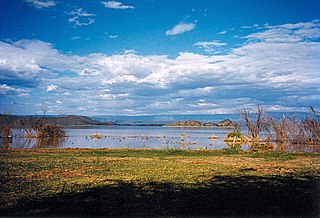
Lake Baringo is, after Lake Turkana, the most northern of the Kenyan Rift Valley lakes, with a surface area of 130 square kilometres (50 sq mi) and an elevation of 970 metres (3,180 ft). The lake is fed by several rivers: the Molo, Perkerra and Ol Arabel. It has no obvious outlet; the waters are assumed to seep through lake sediments into the faulted volcanic bedrock. It is one of the two freshwater lakes in the Rift Valley in Kenya, the other being Lake Naivasha.

Lake Victoria is one of the African Great Lakes. With a surface area of approximately 59,947 km2 (23,146 sq mi), Lake Victoria is Africa's largest lake by area, the world's largest tropical lake, and the world's second-largest fresh water lake by surface area after Lake Superior in North America. In terms of volume, Lake Victoria is the world's ninth-largest continental lake, containing about 2,424 km3 (1.965×109 acre⋅ft) of water. Lake Victoria occupies a shallow depression in Africa. The lake has a maximum depth of between 80 and 84 m (262 and 276 ft) and an average depth of 40 m (130 ft). Its catchment area covers 169,858 km2 (65,583 sq mi). The lake has a shoreline of 7,142 km (4,438 mi) when digitized at the 1:25,000 level, with islands constituting 3.7% of this length.

The Nile perch, also known as the African snook, Goliath perch, African barramundi , Goliath barramundi, Giant lates or the Victoria perch, is a species of freshwater fish in family Latidae of order Perciformes. It is widespread throughout much of the Afrotropical realm, being native to the Congo, Nile, Senegal, Niger and Lake Chad, Volta, Lake Turkana, and other river basins. It also occurs in the brackish waters of Lake Maryut in Egypt. The Nile perch is a fish of substantial economic and food-security importance in East Africa. Originally described as Labrus niloticus, among the marine wrasses, the species has also been referred to as Centropomus niloticus. Common names include African snook, Victoria perch, and many local names in various African languages, such as the Luo name mbuta or mputa. In Tanzania, it is called sangara, sankara, or chenku. In Francophone African countries, it is known as capitaine. Its name in the Hausa language is giwan ruwa, meaning "water elephant".

Tilapia is the common name for nearly a hundred species of cichlid fish from the coelotilapine, coptodonine, heterotilapine, oreochromine, pelmatolapiine, and tilapiine tribes, with the economically most important species placed in the Coptodonini and Oreochromini. Tilapia are mainly freshwater fish inhabiting shallow streams, ponds, rivers, and lakes, and less commonly found living in brackish water. Historically, they have been of major importance in artisanal fishing in Africa, and they are of increasing importance in aquaculture and aquaponics. Tilapia can become a problematic invasive species in new warm-water habitats such as Australia, whether deliberately or accidentally introduced, but generally not in temperate climates due to their inability to survive in cold water.
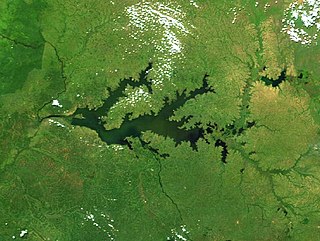
Lake Kyoga is a large shallow lake in Uganda, about 1,720 km2 (660 sq mi) in area and at an elevation of 1,033 metres. The Victoria Nile flows through the lake on its way from Lake Victoria to Lake Albert. The main inflow from Lake Victoria is regulated by the Nalubaale Power Station in Jinja. Another source of water is the Mount Elgon region on the border between Uganda and Kenya. While Lake Kyoga is part of the African Great Lakes system, it is not itself considered a great lake.

The Nile tilapia is a species of tilapia, a cichlid fish native to the northern half of Africa and the Levante area, including Israel, and Lebanon. Numerous introduced populations exist outside its natural range. It is also commercially known as mango fish, nilotica, or boulti. The first name leads to easy confusion with another tilapia which is traded commercially, the mango tilapia.

Lake Kwania is in the districts of Lira, Apac and Amolatar in the Northern Region of Uganda. It is part of a large wetland along the White Nile between Lake Victoria and Lake Albert. The wetland, which includes Lake Kwania, the even larger Lake Kyoga, and other water bodies and swamps, consists of about 3,420 square kilometres (1,320 sq mi) of open water and about 2,180 square kilometres (840 sq mi) of permanent swamps. Of this total, Lake Kwania accounts for 540 square kilometres (210 sq mi), about 16 percent, of the open water.
The silver cyprinid also known as the Lake Victoria sardine, mukene, and omena, is a species of pelagic, freshwater ray-finned fish in the carp family, Cyprinidae from East Africa. It is the only member of the genus Rastrineobola.
Oreochromis esculentus, the Singida tilapia or Graham's tilapia, is a critically endangered species of cichlid endemic to the Lake Victoria basin, including some of its satellite lakes such as Kyoga, in Tanzania, Uganda, and Kenya. Its common name refers to Lake Singida, but this population is the result of an introduction that happened in the 1950s. This fish is highly valued by local fishermen, who know it as ngege.
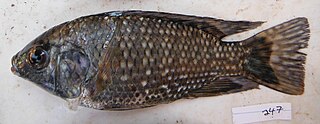
Oreochromis leucostictus is a species of cichlid native to Albertine Rift Valley lakes and associated rivers in DR Congo and Uganda. It has now been introduced widely elsewhere East Africa, and is believed to have negative ecological impact, particularly on native tilapias. This species is reported to reach a standard length of up to 36.3 cm (14.3 in), but is usually much smaller. It is exploited by small-scale fishery and aquaculture operations.
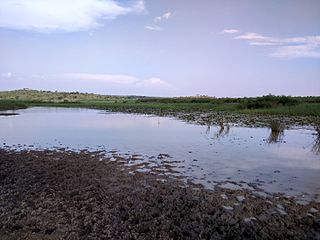
The Yala Swamp is a wetland region of about 175 square kilometres (68 sq mi) in Western Kenya.

There are two major sources of fish in Uganda; one is from aquaculture, the other from fishing in rivers and lakes. The latter has made up the largest and most significant share of all fishing. Open water covers 15.3 percent of Uganda's surface and comprises five major lakes which are the main sources of fish in the country. Lake Victoria continues to be the most important water body in Uganda both in size and contribution to the total fish catch, followed by Lake Albert and Lake Kyoga.
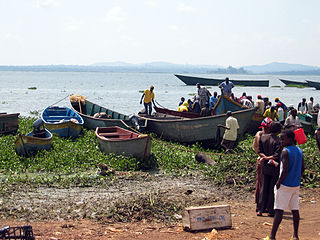
Lake Victoria supports Africa's largest inland fishery, with the majority of the catch being the invasive Nile perch, introduced in the Lake in the 1950s.
There are two major sources of fish in Uganda; one is from aquaculture, the other from fishing in rivers and lakes. Different types of fish flourish in different water sources. The waters of Uganda contain an impressive array of fish species—over 90 in all. This count does not include the Haplochromis complex, which itself is made up of more than 200 species.

Fishing gear and methods used in Uganda are both modern and traditional. Fish in Uganda are caught mostly with plank canoes and to a lesser extent, fiberglass boats. Some dugout canoes are also still being used. The plank canoes are generally 4–12 m (13.12–39.37 ft) in length and dugout canoes average 3.5 m (11.48 ft). The total number of vessels is about 17,000 and about 20% of these are motorized. Artisanal fishermen use various gear including gillnets, seines and hook and line. In a number of localities, traditional methods including baskets, traps and mosquito nets continue to be used. The gear commonly used includes gillnets, lift nets, scoop-nets used in light fishing; hook and line gear and fish traps.
Lowarengak is a town in northern Kenya, near the Kenyan-Ethiopian border. Lowarengak lies on the northwestern margin of Lake Turkana, between the towns of Todenyang to the north, and Nachukui to the south. The town receives fresh water from the Lowarengak and Nakitokonon rivers that drain from the Lapur hills.

Lake Victoria supports Africa's largest inland fishery, with the majority of present catch being the invasive Nile perch, introduced to the Lake in the 1950s. Prior to the introduction of Nile perch as well as Nile tilapia, the fish community was very different and consisted mainly of 'Ngege' and Victoria tilapia as well as vast numbers of Haplochromis species. Fish communities in the first half of the 20th century are known primarily from a unique fisheries survey conducted in 1927-1928 by the Colonial Office.

The Yala River is a river of western Kenya, a tributary of Lake Victoria. It generally flows fast over a rocky bed through a wide valley before joining the Nzoia River to form the Yala Swamp on the border of Lake Victoria. The land along its course is mostly cultivated or used for grazing, with relatively few remnants of the original forest. Soil erosion is visible throughout the river basin, particularly in the lower parts. Projects are underway to exploit the river for hydroelectricity.

Lake Kanyaboli is a lake in the Yala Swamp in western Kenya. It is important as a refuge for fish species that have almost disappeared from Lake Victoria.
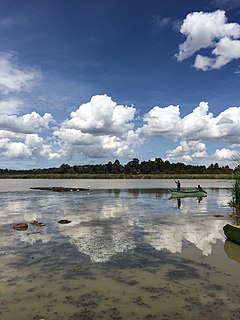
Kesses Dam is a small man-made lake in Kenya. It is one of the sources of the Yala River. It is used as a source of water for irrigation and domestic use, and also for boating and other water activities.
















